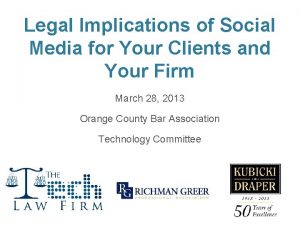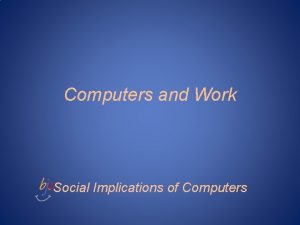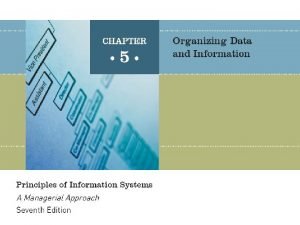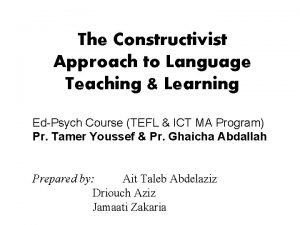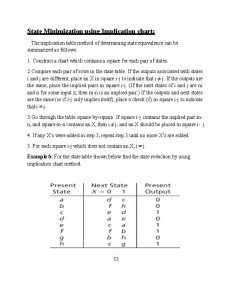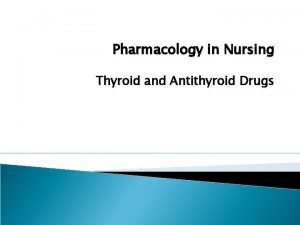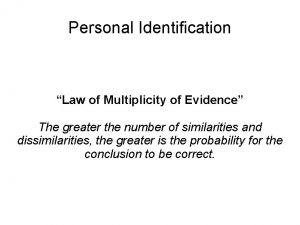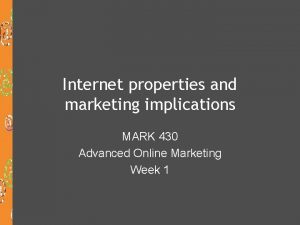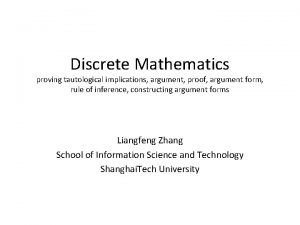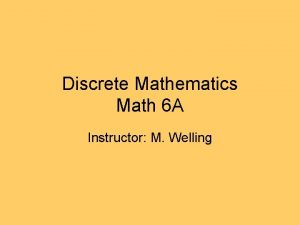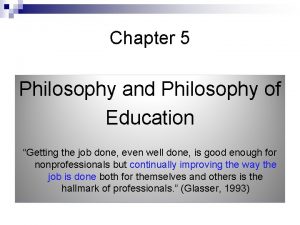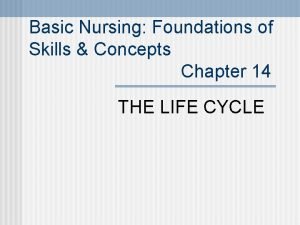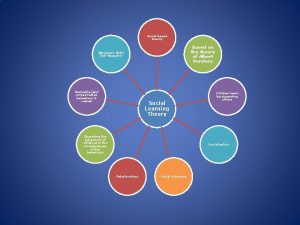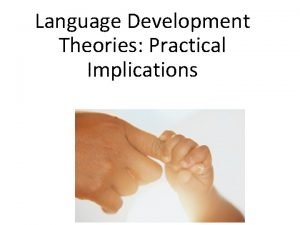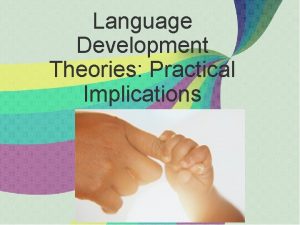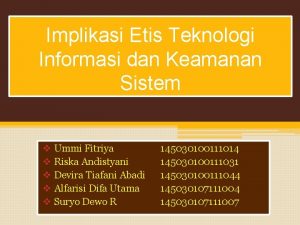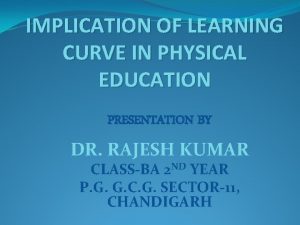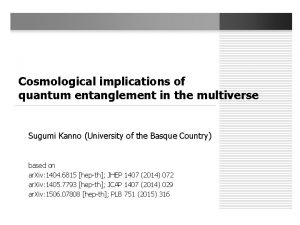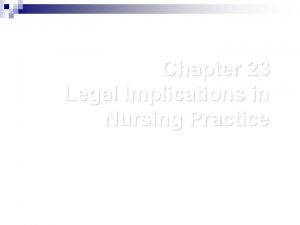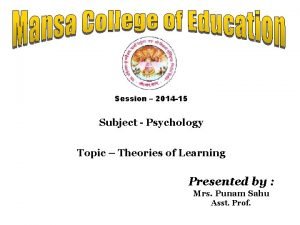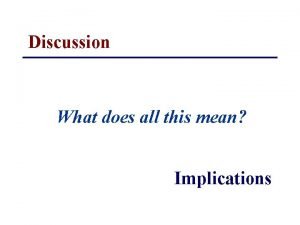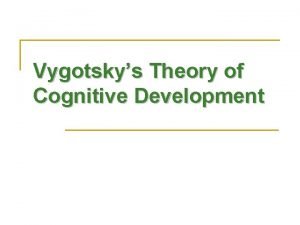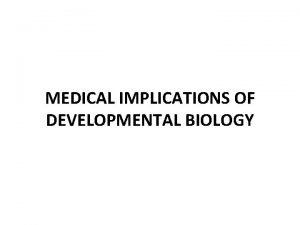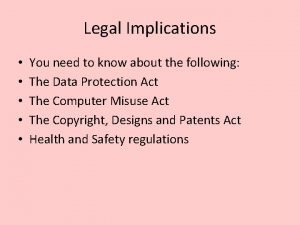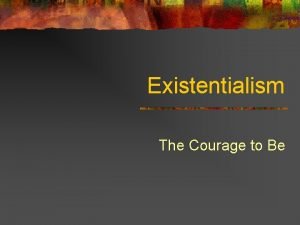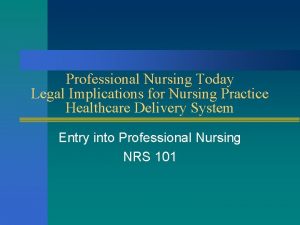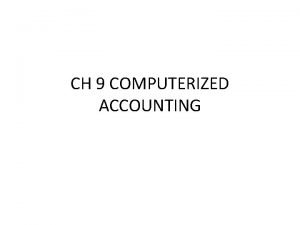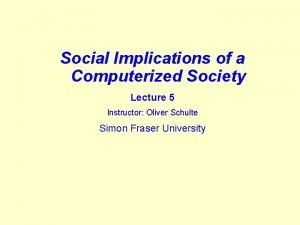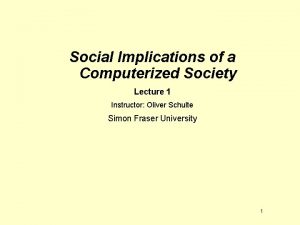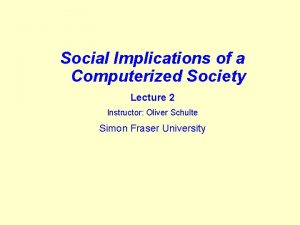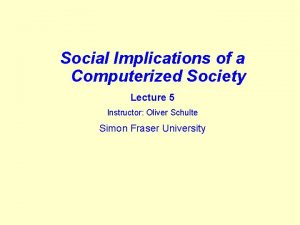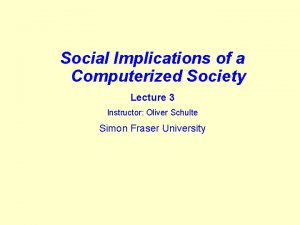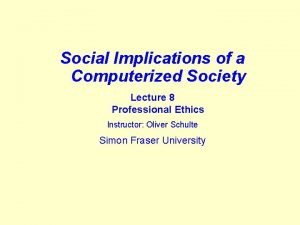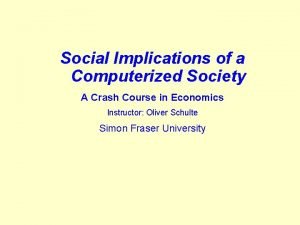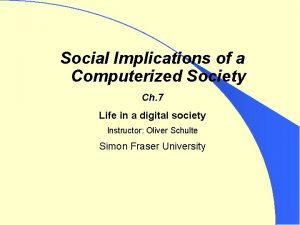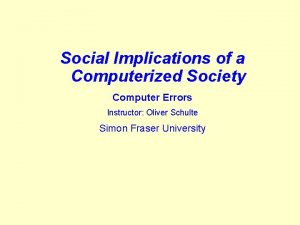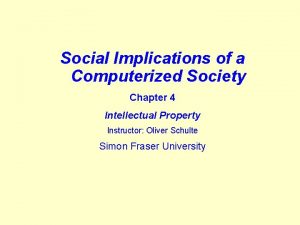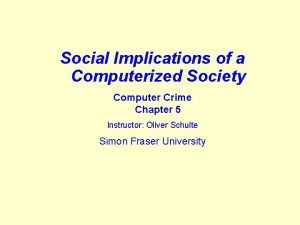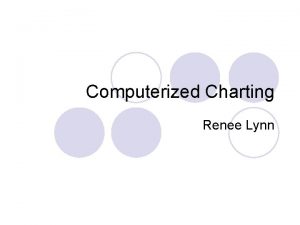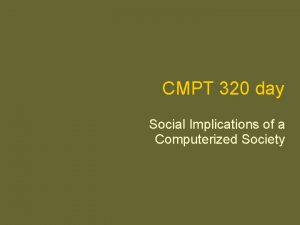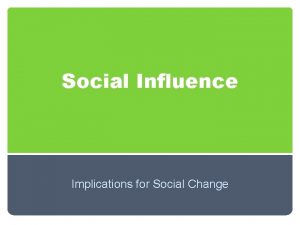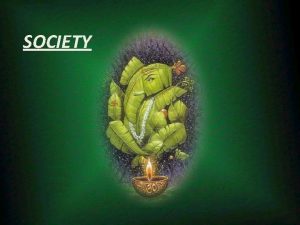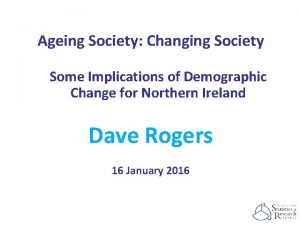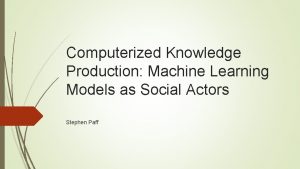Social Implications of a Computerized Society Lecture 4

































- Slides: 33

Social Implications of a Computerized Society Lecture 4 Instructor: Oliver Schulte Simon Fraser University

Outline • • Intellectural Property Protection – Copyright – Patents Traditional Views and Issues: copyright vs. fair use New Issues: Copyright infringement as a mass phenomenon. Do Software patents promote innovation?

Key Concepts • • Copyright Creative Expression Fair Use Public Domain Patent for ideas, processes, devices Obviousness test Open Source Software

Discussion Question • • Who has downloaded music in the last week? Did you infringe copyright? Do you see an ethical problem?

What is copyrighted? • • Creative works and creative expression are protected by copyright. Creator acquires a form of intellectual property. Intellectual property, unlike physical property, is easily copied, hence need for special protection. Copyright applies to: Books, articles, plays, songs, art, movies, software.

What Copyright gets you • • Exclusive right to – Make copies of the work – Produce derivative work, e. g translation (fan fiction? ) – Distribute copies – Perform work in public – Display work (e. g. , video on website) Exception: Fair use - more later

Important Features of Copyright • • • No need to apply for it (contrast with patent). Protects the creative work, not the physical copy. Difference with physical property right (e. g. , car). Copyright expires, then work enters public domain. (With movies, Congress keeps extending the timeline, now up to 95 years).

What is not protected by copyright • • Facts Ideas Concepts Processes (including algorithms) Methods of Operation It’s the expression of an idea, not the idea itself that is protected. Boundary can be unclear - software programs? ! Reimplementations, reverse engineering is okay.

Patents • • Protects ideas as embedded in devices and processes. Need to apply for patent protection. Idea cannot be obvious or already known. Inventor has monopoly on using the idea for a specified amount of time.

Ethics of Copyright: Liberty/Rights Perspective • • Copyright/patent is mainly a positive/claim right to intellectual property. 3 rd-person implications: prevent others from using your creation/invention. But the owner of a copy of a creation (e. g. , song on CD) has a property right in her physical copy. This is a negative liberty to use her property as she sees fit (e. g. , share the CD with friends). So copyright is balanced by fair use exceptions.

Ethics of Copyright: Utilitarian Perspective • • • Promote innovation, and so social benefit, by allowing the creator to benefit from his creation. Promote social benefits by entering creation into public domain. The social benefits of free use must be considered, not only the intellectual property right of the creator.

International Issues • • Many countries do not have legal protection for intellectual property or do not enforce it, e. g. China. One argument against international enforcement is from a global justice/developmental perspective (e. g. , Stieglitz, “Making Globalization Work”). – Copyright/patent holders usually in industrialized world---developing countries too poor to pay. – Developing countries needs ideas in the public domain to develop.

Discussion Question • • • The HIV prevalence in sub-Saharan Africa is estimated at 24 million cases. Generic drugs could cure or keep alive many people, but Western pharmaceuticals oppose relaxing patent protection for African patients. Do you think that Africans should be able to use generic versions of Aids drugs? What are the pros and cons?

New Challenges • • Digital technology enables high-quality, high-quantity copying (vs. photocopiers) Scanners, compression of music/audio files. Web makes distributing and transferring digital content easy. Easy to adapt works of others (photoshop, vidding).

Copyright Infringement as a Mass Phenomeon • • • Traditionally copyright is a B 2 B issue, because mass copying required equipment. For digital content, downloading and using intellectual property has become a mass issue. Larry Lessig: “Our kids are living against the law”.

Discussion Questions on Fair Use Which of the following constitute fair use of music files in your opinion? • Burning a CD for a friend. • Making the music available on a peer to peer network (limewire, bittorrent). • Moving music from one of your computers to the next, say from an Ipod. • Posting the file on the internet for downloading.

Fair Use of Copyrighted Material • • Typical Examples: criticism, comment, parody, news reporting, teaching, scholarship, research. Four factor test: – Purpose: for profit or educational. – Nature of work: fiction vs. factual report. – Amount and significance (e. g. > 30%). – Effect on potential market or value of work (e. g. , depressing CD sales vs. home use).

Discussion Question • • • Fan fiction is derivative fiction based on the characters in the original novel. More than 40, 000 Harry Potter stories on the web. Is fan fiction fair use? Apply the four factors.

Are internet companies responsible for copyright infringement? • • Do Internet Service Providers or Search Engines have a duty to monitor their users/queries and block download websites? Do they have a duty to block download sites when notified of the copyright infringement? What sort of “notification” should be required?

Copyright and New Technology: Did Video kill a movie star? • • Movie Studios vs. Sony: sued Sony for making betamax video cassettes. Supreme Court found in favour of Sony. private, noncommercial use usually fair. a device with substantial legal uses should not be penalized because some people use it to break copyright.

Music Sharing: The Napster Case • • • Napster: file sharing site. 50 mill users. Record companies sued and won. file sharing is not personal use. extensive file sharing seems to impact music market. Difference with Video Recorder: – Napster has the right, ability and duty to supervise its system. – Napster profits from the copyright infringement.

The Internet and then the Empire strikes back • • Gnutella, Grokster: peer-to-peer systems without a central service. Owners were sued. Music industry won again. – Services encouraged copyright enfringement (? !) – Copyright infringement was substantial part of their business model. – Critics: P 2 P technology has been discouraged.

Copyright Enforcement: Technological Approach • • • For Software: Activation numbers, expiration dates, copy protection. Largely dropped because customers dislike it. Compare: reselling a (text)book vs. selling a software copy. CD sales are down decline cd sales. pdf. Fake damaged music copies (decoys) or music copies with ads (Coke).

Copyright Enforcement: Suing and Taxing • • Sue ISPs whose subscribers operate filesharing, sue university students. Sue against new technology: CD burners delayed since 1988, Tivo, DVD players that can copy movies. Taxing: levies on blank CDs, Ipods, PCs, printers, … (in EU, Canada, U. S. ). What is more important: free use of technology or prevention of crimes?

Copyright Enforcement: Market Approach • • • BMI, copyright clearance centre, Can. Copy: represent groups of copyright holders, charge users one fee for everything. Advertising (e. g. , the new Napster). Website (e. g. , You. Tube pays company (e. g. , Warner Brothers) when some of its material appears in a post.

Discussion Question • • What do you think is the best approach to copying music files? What about video files? Larry Lessig (Stanford U) on intellectual property in the digital age.

Software Copyright • • • Difficult area. Outright copying violates copyright. So does “translating” into another programming language. But reimplementing the basic idea of the program---the algorithm---does not. Compare with cooking recipe. “Look and feel” is not copyrighted. MS Windows can copy ideas from Mac GUI.

Software Patents • • Software can generally be patented. Examples: – Amazon holds patent for 1 -click shopping. (Is that an obvious idea? ) – Alcatel-Lucent holds MP 3 patents. – Blackberry was sued for patent infringement.

Are Software Patents a Good Thing? The Main Issue: Do they Promote or Prevent Innovation? • • Pro: Reward Inventors, make companies willing to market invention. Con: – Software systems combine many small ideas--stifle new innovations. – New programs must worry about being sued--hard to keep track of all patents, unclear legal situation.

Proprietary Software = Bad Software? • • • Companies often develop software in a rush, with a minimum of effort, to gain customers before they put in more effort. Later try to fix problems, but hard to build on a bad foundation---”legacy code”. Clients become dependent on system providers---SFU and SIMS?

Open Source Movement • • Free Software Movement. Copyleft: people can use, modify, distribute, but only if the same applies to their produccts. Creative Commons: new kinds of licences. Examples: Linux, Firefox, Apache.

Discussion Question Do you think all software should be free? What are the pros and cons? Are there some types of software that should be free or proprietary?

Free Software • • • Pros: – Better quality. – Promotes use in innovative applications. Cons: – Would there be enough incentive to develop programs? – Who provides technical support? Some businesses embrace open source. – Sun: GPL license for Java. – IBM: promotes Linux.
 Legal implications of social media
Legal implications of social media Social implications of computers
Social implications of computers 01:640:244 lecture notes - lecture 15: plat, idah, farad
01:640:244 lecture notes - lecture 15: plat, idah, farad Gertler econ
Gertler econ Social thinking and social influence in psychology
Social thinking and social influence in psychology Social thinking social influence social relations
Social thinking social influence social relations Characteristics of database approach
Characteristics of database approach Constructivist approach
Constructivist approach Implication table state minimization
Implication table state minimization Nursing implications for synthroid
Nursing implications for synthroid Multiplicity law
Multiplicity law Media have commercial implications
Media have commercial implications Marketing implications
Marketing implications Tautological implication
Tautological implication Implications math
Implications math Educational philosophies
Educational philosophies Cengage learning
Cengage learning Nursing implications
Nursing implications Social learning theory bandura 1971
Social learning theory bandura 1971 Implications of nativist theory
Implications of nativist theory Implications of nativist theory
Implications of nativist theory Implikasi etis adalah
Implikasi etis adalah Learning curve in physical education
Learning curve in physical education Implications of quantum entanglement
Implications of quantum entanglement Chapter 23 legal implications in nursing practice
Chapter 23 legal implications in nursing practice Ranexa nursing implications
Ranexa nursing implications Humalog nursing implications
Humalog nursing implications S-r bond theory
S-r bond theory Discussion and implications
Discussion and implications Guided participation examples
Guided participation examples Medical implications of developmental biology
Medical implications of developmental biology What is legal implications
What is legal implications Educational implications of existentialism
Educational implications of existentialism Legal implications in nursing practice
Legal implications in nursing practice
